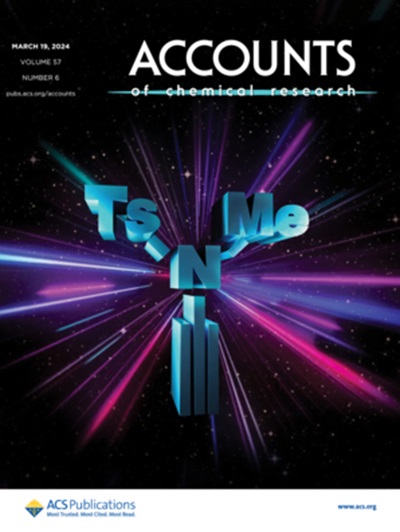Tailoring Light-Matter Interactions in 2D Semiconductors.
IF 17.7
1区 化学
Q1 CHEMISTRY, MULTIDISCIPLINARY
引用次数: 0
Abstract
ConspectusTwo-dimensional (2D) crystals have had a sweeping influence on the condensed matter physics and materials science communities for over two decades. Their thinness and ability to be configured into layered and twisted heterostructures has enabled 2D crystals to become a platform material of choice to uncover many intriguing phenomena, including superconductivity, the fractional quantum anomalous Hall effect, spin textures, strain domain walls, and distinct spin-valley transitions. This versatility is on display in 2D semiconductor monolayers, which exhibit strong light-matter coupling to a rich host of excitonic states and valley selective transitions. The optical physics of 2D semiconductors is tunable through manipulation of their structure, chemical composition, mutual orientation in superlattices, and strain. Together, such adjustments give rise to a plethora of exciting applications in optics, spintronics, and quantum sensing. Our contributions to the 2D materials community have focused on developing chemical strategies for precision nanostructure synthesis, elucidating emergent optical phenomena through detailed spectroscopic analysis, and creating new 2D heterostructures that support the localization and manipulation of quasiparticle states. This Account examines selected aspects of our recent work on tailoring light-matter interactions in 2D semiconductors. We discuss how synthetic manipulation of a 2D crystal's dimensions, edge structure, strain state, and coupling to other molecular species and lattices renders specific properties. Through this article we wish to draw attention to the rich chemistry of 2D crystals and the active role chemistry should play in opening new avenues of research in 2D materials.裁剪二维半导体中的光-物质相互作用。
二十年来,二维晶体对凝聚态物理和材料科学界产生了广泛的影响。它们的薄度和配置成层状和扭曲异质结构的能力使二维晶体成为揭示许多有趣现象的首选平台材料,包括超导性、分数量子反常霍尔效应、自旋织构、应变畴壁和独特的自旋谷跃迁。这种多功能性在二维半导体单层中得到了体现,它表现出强烈的光-物质耦合,具有丰富的激子态和谷选择跃迁。二维半导体的光学物理可以通过操纵它们的结构、化学成分、超晶格中的相互取向和应变来调节。总之,这样的调整在光学、自旋电子学和量子传感方面产生了大量令人兴奋的应用。我们对二维材料领域的贡献主要集中在开发精确纳米结构合成的化学策略,通过详细的光谱分析阐明新兴的光学现象,以及创建新的二维异质结构,支持准粒子态的定位和操纵。本文考察了我们最近在二维半导体中裁剪光-物质相互作用的工作的选定方面。我们讨论了二维晶体的尺寸、边缘结构、应变状态以及与其他分子种类和晶格的耦合如何产生特定的性质。通过这篇文章,我们希望引起人们对二维晶体丰富的化学性质的关注,以及化学在开辟二维材料研究新途径方面应发挥的积极作用。
本文章由计算机程序翻译,如有差异,请以英文原文为准。
求助全文
约1分钟内获得全文
求助全文
来源期刊

Accounts of Chemical Research
化学-化学综合
CiteScore
31.40
自引率
1.10%
发文量
312
审稿时长
2 months
期刊介绍:
Accounts of Chemical Research presents short, concise and critical articles offering easy-to-read overviews of basic research and applications in all areas of chemistry and biochemistry. These short reviews focus on research from the author’s own laboratory and are designed to teach the reader about a research project. In addition, Accounts of Chemical Research publishes commentaries that give an informed opinion on a current research problem. Special Issues online are devoted to a single topic of unusual activity and significance.
Accounts of Chemical Research replaces the traditional article abstract with an article "Conspectus." These entries synopsize the research affording the reader a closer look at the content and significance of an article. Through this provision of a more detailed description of the article contents, the Conspectus enhances the article's discoverability by search engines and the exposure for the research.
 求助内容:
求助内容: 应助结果提醒方式:
应助结果提醒方式:


